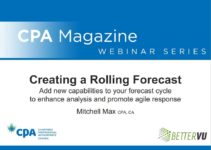CPA Magazine – Creating a rolling forecast
Date: November 10, 2014
Name: CPA Magazine – Creating a rolling forecast
Many organizations are looking beyond the fiscal year to create their forecast. Moreover, organizations are implementing rolling forecast to update on a monthly basis to ensure their performance and forecast are aligned. Mitchell Max, the co-Founder of Better Vu, will provide his insight on creating a rolling forecast. This webinar will help organizations to create a must more effective and efficient rolling forecast that can also provide visibility in future. Max will provide his 20 years of knowledge and expertise in performance management to help organizations have a better understanding of forecasting.
In average, organizations review their financial forecast quarterly. Max indicates the trend on forecasting has shifted from once or twice to quarterly. Organizations are realizing the importance of forecast; therefore, Max believes the new trend will eventually shift from quarterly to monthly.
There are four reasons why organizations need to forecast.
- Financial Forecast
- Projections / Commitments
- Operational Forecasting
- Actions and Decisions
As for financial forecast, there is a need from CFO of getting the relevant financial information to determine the variance. Management will use the variance to forecast a plan. Organizations need to know if they are hitting the target or if any further actions required for their projections. Many organizations are focusing on operation matrix to determine their operating forecast. Lastly, organizations require knowing if the outcome is aligned to their objectives; otherwise, new actions and decisions will be initiated.
In general, forecast is related to planning. Organizations think backward from outcome to design their forecast. When new facts appear, the budget will be irrelevant. Furthermore, organizations need to adapt the change, which influence the forecast model.
“Plan is a plan at the point of time; forecast begins at an equivalence of plan”
Max defines the main purpose of forecasting is to facilitate decision-making based on an understanding of likely future outcomes. Organizations need to look at the gap between the projection and the target. Organizations will determine ways to close the gap. Therefore, Max believes forecast is not the answer to operation issues; in fact, it is the way to the answer.
In traditional forecast, there is a consent length of time. Organizations are forecasting to the wall if they will determine whether or not if their performance are hitting the projection. In rolling forecast, organizations are always moving forward and looking at 12-18 months in advance. Therefore the main difference between the traditional and rolling forecasts is the business cycle.
Organizations are facing many challenges during the forecast process. The first challenge is time and effort. Forecast can take up a lot of time to prepare. The second challenge is the timeliness. Organizations will face time pressure, which can create irrelevant data and assumptions. The third challenge is the reliability. Forecast needs to be accurate, freedom from bias, and integrated with consistency. The fourth challenge is the tools. Organizations will need to determine the best tools to integrate data information into forecast model.
Max suggests forecast should not be 4 or 12 times per year; instead, organizations should complete their forecast in days within monthly performance cycle. The forecast model should base on drivers and data, but not consolidate financial submissions. This will help organizations to leverage data. Iteration and simulation are important. Lastly, Max recommends forecast is basis for decision making, not a prediction of the future.
There are 3 key concepts Max want organizations to implement in their forecast.
Concept #1: Forecast for discussion and simulation, not an answer
Max indicates organizations should create models that change based on drivers and assumptions. Organizations need to know “if-what”, “so-what”, and “do-what”. Organizations should concentrate on retention and growth.
“Create models based on key drivers that can be changed at a high level”
Concept #2: Model, not consolidate
Max believes forecast model should begin with operations and ends with finance. Therefore, forecast process can be separate into different layers. Organization can start with demand forecast, then supply forecast, and end with result forecast. Each layer will leverage the drivers. Organizations can focus on the drives and key to control. The system will do the work for the organization. Organizations need to allow the system to forecast by exception and let the system do the heavy lifting. The system need to have the ability to overwrite. The system also needs to be flexible. This means system can set assumptions by dimensions and let the system drive the details. The system can identify or alert organization the change to support their decision making.
Concept #3: Collaborate is not equal to coordinate
Max suggests organization to engage those closest to the front. This means receiving feedback within the organization. The organization need to provide a sandbox for simulation. This will allow the forecast to be flexible and provide sensitivity analysis. There is always room for measure and improvement. Organization need to reward for making accurate forecast happen.
In budget process, Max believes organizations need to recognize that each has a role. Budget should be a guide and goal, not an obligation or regulation. Budget should not prevent a good forecast to avoid linking variances. Moreover, organization should shift the effort from budget to forecast by redirect the resources.
In the future, Max wants organizations need to assess their forecasting needs and capabilities. They need to understand and create driver-based business model. They should start looking beyond the fiscal year and incorporate flexible forecasting into performance cycle.
“Not about creating prediction, it is to crate ways to engagement to forecasting”





